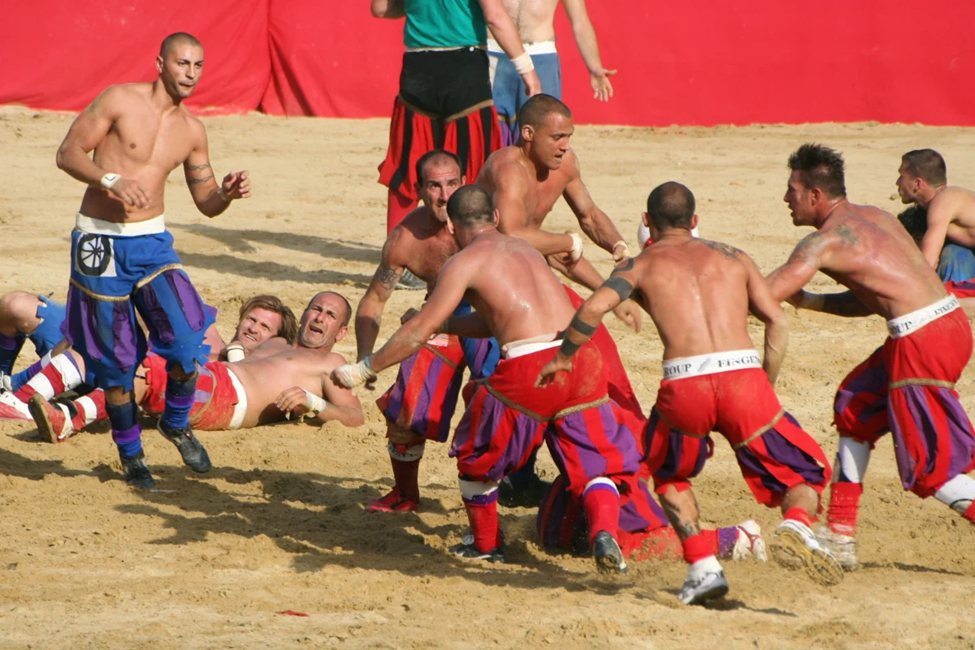By: Kira Dykes
When people think of extreme sports, activities like skydiving, skiing, or BMX racing may come to mind. And while each requires their own set of skills and rigorous training, one historical sport might have them beat when it comes to the physical demands of its players. Dating all the way back to the 1530’s, it is considered a mix of football, rugby, and wrestling, where players compete to honor the tradition and history of Italy, and nearly anything goes. Described by the King of France in 1574 as “Too small to be a war, too cruel to be a game,” this is Calcio Storico Fiorentino, or historical Florentine football in English.
The object of the game is simple. Two teams of 27 calciantes, or players have 50 minutes to land the ball in the caccia cacce, or goal, as many times as they can. If they miss, the other team earns half a point. There are four teams in total, each of which represents one of the districts of Florence. According to italyperfect.com, “Rossi (red) is Santa Maria Novella, Bianchi (white) is Santo Spirito, Azzurri (blue) is Santa Croce and Verdi (green) is San Giovanni.”
The only requirements to play are to be born or have lived for at least ten years in Florence in one of those districts, and to be male. An article published to medium.com states that there were a few women’s programs that play throughout the year as well, but since it’s been seven years since it was written, there very well may be more.
Typical attire is very barebones, as players don’t wear any kind of protective gear, aside from shoes. Pants meant to resemble those from the Renaissance are usually worn, bearing their team’s respective color. This makes the sport more dangerous than most; hospitalization is common and can last for months.
Lack of protective gear isn’t the only reason for injury, however. The rules themselves, while designed to prevent the game from becoming too violent, give a lot of leeway to its players. Thelocal.it explains that “many fighting techniques (including martial arts) are allowed,” as well as “bare-knuckle boxing,” italyperfect.com claims. “Moves such as punches, kicks, headbutts and wrestling are still considered fair game for players to immobilize their opponents,” wantedinrome.com details, meaning things can get very intense for both players and spectators alike.
Things get so extreme that each team gets their own version of a mediator, called a standard-bearer, to interfere if things begin to get too heated. This is very important, as substitutions are not allowed, meaning that if a player is too injured to continue, the team is down one.
What’s more, “Classic moves, such as kicks to the head or when multiple players attack one opponent, are now banned to avoid fatal injuries. In 2007, a brawl took place which resulted in 50 players being arrested and a one-year ban of the event,” wantedinrome.com also explains. Yes, all 50 players were taken to court and a new rule had to be added that disallowed convicted criminals from participating.
The reason behind why players brawl so valiantly is due to a key rule: until another point is scored, those that have been tackled to the ground cannot return to playing. The main strategy consists of having 15 players on each side clear a path through the field to the goal, while the other 12 focus on getting the ball there.
Played only once a year, Calcio Storico Fiorentino consists of two semifinals and a final on the feast day of John the Baptist, Florence’s patron saint, June 24th. That day, there is a colorful parade including bands and flag throwing, and people in historical costumes. “The stands around the field are full of supporters dressed in the two colors to support their teams in the final game,” italyperfect.com describes.
The winning team will receive not a trophy or a medal, but something more culturally significant. Back when the sport was first played, Florence was under siege, and the game was a way to show off their strength to the Imperial and Spanish armies. As such, a Chianina, the world’s largest breed of cow, was a very valuable prize. Even now, its symbolic significance cannot be understated. The cow joins the parade alongside players and spectators alike.
Despite its reputation of being one of the most brutal sports out there, Calcio Storico is more about honoring the history and legacy of Florence as well as its people. For its players, tight bonds are formed amongst teammates, while the bond they have with their city grows even stronger. For the audience, it’s a chance to take part in a celebration that spans across multiple generations and time periods and bask in the exuberant atmosphere while supporting local members of their communities.

For those who have never watched a match before, it can be hard to know where to look.
Photo from: italyperfect.com

